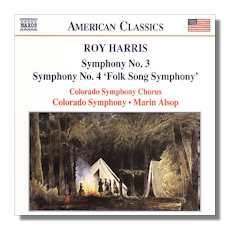
The Internet's Premier Classical Music Source
Related Links
- Harris Reviews
- Latest Reviews
- More Reviews
-
By Composer
-
Collections
DVD & Blu-ray
Books
Concert Reviews
Articles/Interviews
Software
Audio
Search Amazon
Recommended Links
Site News
 CD Review
CD Review
Roy Harris

Inventing American Music
- Symphony #3 (1938)
- Symphony #4 "Folk Song Symphony" for Orchestra & Chorus (1939) *
* Colorado Symphony Chorus
Colorado Symphony Orchestra/Marin Alsop
Naxos 8.559227 58:47
Summary for the Busy Executive: The mighty Third and the should-have-been mighty Fourth.
A protégé of Bernstein, Marin Alsop performs here Harris's Third, one of Bernstein's party pieces. He recorded it at least twice (I prefer the earlier stereo version with the New York Phil – Sony 60594). Alsop's Fourth restores to the catalogue one of Harris's most interesting scores. On paper, at any rate, this looks like a good deal.
I've found Alsop's recordings maddeningly inconsistent over the years. She can deliver with eloquence, or she can bore the Lederhosen off you. As far as her contribution to this CD goes, she's done a terrific job, providing vital readings of these two scores. Her recording of the Third differs from Bernstein's in that she makes the work move less like an epic, more like a lyric poem – as it turns out, a legitimate approach. The Third, like almost all of Harris's music, primarily moves through counterpoint. Alsop's slightly scaled-back point of view allows you to hear the lines clearly. Koussevitzky called this score the "first great symphony by an American composer." He was mistaken, of course (Ives and Copland had already written great symphonies, as had Harris), but not about the quality of the work.
On repeated listening, it turns out that this score is hardly a likely candidate for Great Symphony. Indeed, it seems as though Harris has pulled off the impossible. The phrases move in fragments, sometimes ending on an "extra step," like a dancer who goes on a beat too long or ends on the wrong foot, almost like a stumble. The harmonies, though eminently tonal, lie in weird territory. The form of the work – a single movement in five large pieces – seems discombobulated. No section has an obvious connection with another. Yet, somehow Harris brings all of this mess into order. The counterpoint absolutely amazes – non-academic, although it ends with a vigorous fugue. Bits that shouldn't go together fit with the click of a well-made box. Despite the different sections, the listener traverses the symphony in one large arc. One thing leads to another with, to quote Bernstein on Beethoven, "inevitability." Written almost seventy years ago, Harris's score continues to shine like a ! new morning.
Harris's Fourth, finished shortly after the Third, represents Harris's take on folk music. Most music historians and critics credit Virgil Thomson with showing American composers how to put American folk music to Modernist purposes. Aaron Copland publicly acknowledged his debt. Harris lies closer to Copland than to Thomson, but all three manage to integrate folk melody into their own individual idioms. Harris wrote his Fourth for community chorus and orchestra. The choral writing hasn't the complexity of his a cappella pieces. Nevertheless, each movement burns white-hot with inspiration. Harris gives you a very personal take on such chestnuts as "Streets of Laredo," "The Girl I Left Behind Me," and "The Trumpet Sounds in-a My Soul," among others. There's not a weak moment in the entire score. Harris takes familiar – even over-familiar – tunes and bends them in extremely interesting ways. Yet, for some reason, it never coalesces into a convincing whole. In seven movements – "! The Girl I Left Behind Me" (fast), "Western Cowboy" (slow), "Interlude: Dance Tunes for Strings and Percussion" (fast), "Mountaineer Love Song" (slow), "Interlude: Dance Tunes for Full Orchestra" (fast), "Negro Fantasy" (slow), and "Johnny Comes Marching Home" (fast) – it may run longer than it should. I wonder what would happen if you cut two of the slow movements. I'd choose "Western Cowboy" and "Mountaineer Love Song" and move "Negro Fantasy" to the middle. I believe the symphony would move more convincingly, without the kind of backtracking that three long slow movements, similar in mood, introduce to the work. Nothing is wrong with the any of these movements per se. Indeed you could pick any of the three slow movements to the same effect. I just happen to like the "Negro Fantasy" best.
As I've said, of the recorded performances of the Third I've encountered, I regard the Sony Bernstein as the one to beat. However, there are at least two recordings of Koussevitzky out there, and those have every chance of being considerable, even in mono. It says much for Alsop that Bernstein's reading doesn't blow hers away. She takes a different and valid approach and consequently opens up the symphony, makes you see it in new ways. The long-time only recording of Harris's Fourth was Abravanel's with the Utah (nla), although Vladimir Golshmann led an earlier one – as far as I'm concerned, not really acceptable. I always liked Abravanel's music-making as well as his repertoire – a conductor who doesn't get much credit nowadays. The sound of the Utah Symphony couldn't compete with its glossier compatriots, but it played with a sense of conviction. Alsop's Colorado Symphony matches their conviction and plays better. However, the chorus really isn't up to Abravanel's, which I! suspect of containing ringers from BYU. The Colorado singers really are Harris's community chorus. They tend to poop out over the long haul. Cutoffs are ragged, but not terrible enough to ruin the performance. Alsop's orchestra crackles and pops. If the "Folksong Symphony" intrigues you, this is the disc to get.
Copyright © 2008, Steve Schwartz




















